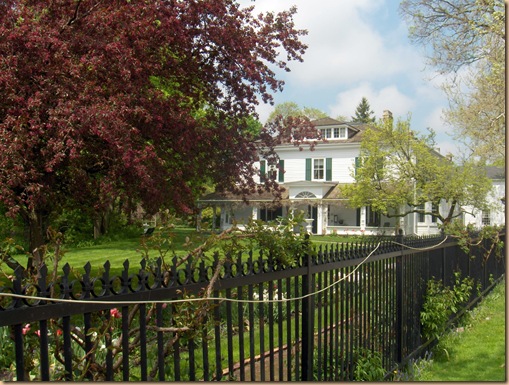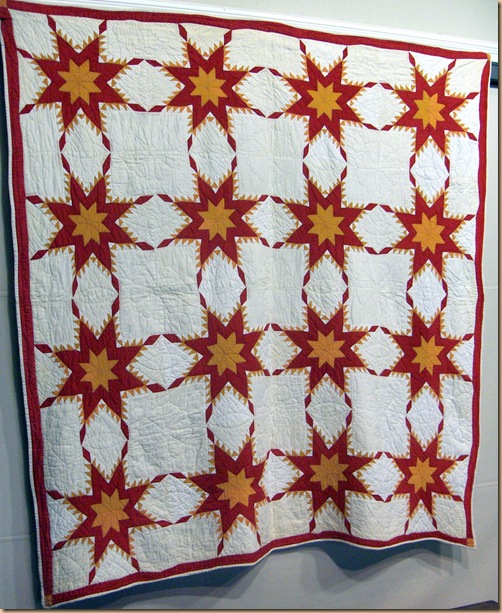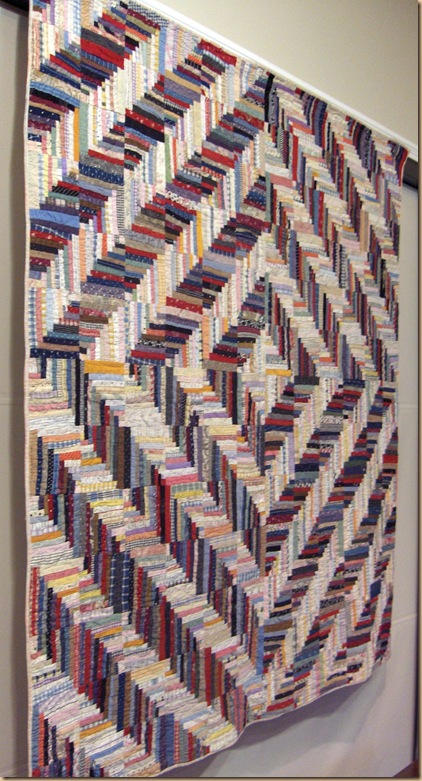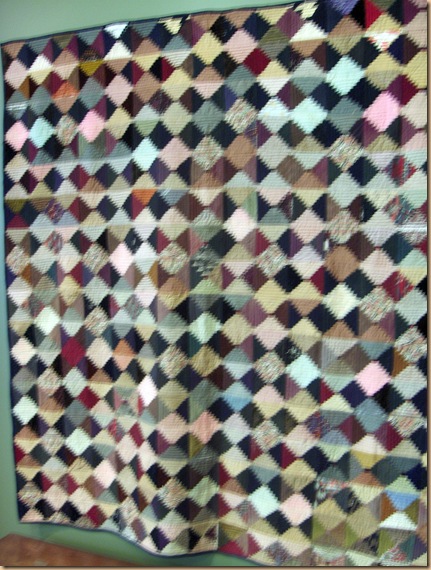On Sunday, I had the opportunity to check out a heritage quilt show at Eldon House in honour of Quilt Ontario’s annual conference taking place in London this year (May 25-28 at University of Western Ontario, http://www.quiltontario2011.blogspot.com/). This exhibit is a partnership between Museum London and Fanshawe Pioneer Village, displaying a small selection of their collections. I also was able to take part in a hand quilting workshop. It was a wonderful afternoon as we chatted and giggled over whose stitches were the messiest and whose quilt strips were the most crooked. Our instructor, Lorraine Swanson of the London Friendship Quilters’ Guild was excellent and the workshop was well worth the money. I have done a bit of hand quilting before but no piecing so it was interesting to try this out.
I learned some great tips as well. Between my bad eyes and my injured hand, threading a needle is extremely difficult for me but two little tricks I learned have helped a great deal. One was to hold the needle above something white (like a piece of paper) and this will help you see the eye better. The other was…are you ready for this?….that there is a “right” and “wrong” side to a needle. No, not the sharp point vs. the eye. What she said was that there is right and wrong side to the opening of the needle’s eye and trying to thread the “wrong” side is close to impossible. Seemed weird but it worked!
A Feathered Star Quilt, early 20th century, a typical star pattern using red and orange diamonds to form stars and then smaller diamonds to create a feathered appearance
Barn Raising Quilt, 1880-1910, a variation of the log cabin pattern in which the light and dark fabrics are arranged to form concentric diamonds, from Fanshawe Pioneer Village
Log Cabin Quilt, late 19th century, a traditional log cabin design
Another log cabin design, 1890, from Fanshawe Pioneer Village
Streak of Lightning, 1880-1910, from Fanshawe Pioneer Village, a rare variation of the log cabin quilt, a unique layout in which the dark and light strips are laid out to form a distinctive zigzag (lightning bolt) pattern
Lone Star Quilt, early 20th century, considered one of the most difficult quilt patterns, mostly handmade but edges were finished by machine, star formed by pink and white diamonds
A crazy quilt titled Sweet Repose, signed and dated 1896, Mrs. A. Westman, hand quilted using over 100 different stitches, incorporates many different materials including those from family clothing like women’s clothing and men’s ties, made to commemorate special events during the late 19th century in the Western Ontario area, even includes tickets from various events and family names that have been incorporated into the quilt
Chevron Log Cabin Quilt, 1920s, sometimes called the Half Log Cabin design, centre square is placed up in the corner instead of the middle, usually in this variation the dark and light contrasts are eliminated
For this workshop we were given the opportunity to make a log cabin block sized to be a “mug rug”. This one is mine. Yeah, I know. I need some practice with my stitches but for my first time hand stitching in about 40 years (and the aging eyes and hands) as well as the really poor lighting in the place (my only complaint about the day), I’m actually pretty proud of myself. I’m even going looking for my fabric stash later today so I can see if I can find some that would work for making more of these. I figure some of these along with the coffee cup sleeves I’ve made would make for a nice little gift set for someone special.
About log cabin quilts: The traditional red centre signifies the hearth, the heart of the home and the strips around it are representative of the logs that made up the walls of the home. The light coloured logs symbolize the happiness and the dark coloured ones symbolize the sadness in life. The earliest dated and signed log cabin quilt is from 1869 in the United States although some believe that this pattern actually dates back to Egyptian times and much earlier European quilts have been found. When the quilts were first made, the pieces were generally tacked onto a foundation piece because the fabrics being used were bits from worn pieces of clothing and this added extra warmth and stability to the finished quilt. As seen in some of the quilts above, there are a variety of variations to the basic log cabin quilt based on how the squares are laid out, in which way the lights and darks are lined up, by turning the squares on point, and so on.
http://www.womenfolk.com/quilt_pattern_history/logcabin.htm
http://ezinearticles.com/?Fascinating-History-of-Log-Cabin-Quilt-Designs&id=5020963
Just had to share this final shot the lovely spread they put on at Eldon House when there are any lectures, workshops, or other special events…it really adds a lovely bit of character to any event you attend there!











Leave a Reply